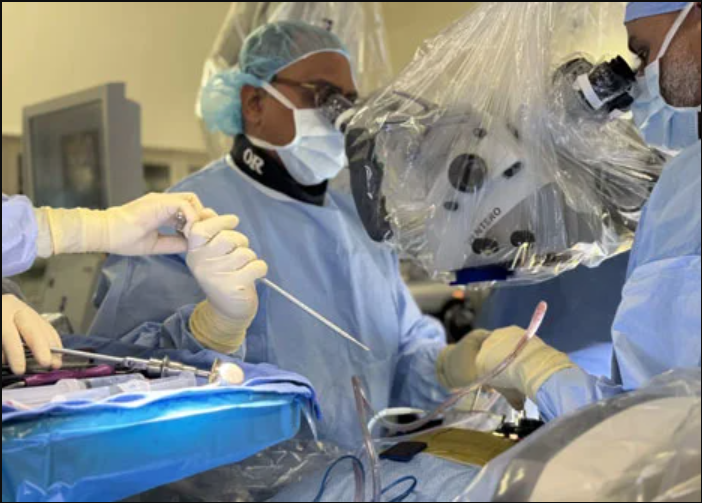If you’re reading this, chances are you know the relentless grip of back or neck pain. It can steal your sleep, limit your activities, and cast a shadow over every aspect of your life. For many, after trying conservative treatments, the thought of surgery looms large – often accompanied by images of long incisions, lengthy hospital stays, and arduous recoveries.
But what if there was another way? A path to relief that is less disruptive, more precise, and often leads to a quicker return to the life you love? This is the promise of minimally invasive spine surgery (MIS), and at the heart of this transformative approach lies the unparalleled expertise of the surgeons who perform it.
What is Minimally Invasive Spine Surgery?
Unlike traditional “open” spine surgery, which often requires a large incision to expose the surgical area by moving aside significant muscle and tissue, MIS techniques aim to achieve the same surgical goals with much less disruption.
Imagine a “keyhole” approach for your spine. MIS surgeons use specialized instruments, tiny cameras (endoscopes), and microscopic visualization through small incisions, sometimes no bigger than a centimetre or two. This allows them to navigate to the source of the problem – be it a herniated disc, spinal stenosis, or instability – with incredible precision, minimizing damage to surrounding healthy tissue.
The “Why” Behind MIS: Significant Patient Benefits
The advantages of this nuanced approach are substantial for patients:
- Smaller Incisions & Less Muscle Damage: This translates directly to less trauma to your body.
- Reduced Post-Operative Pain: With less tissue disruption, patients often experience significantly less pain after surgery.
- Shorter Hospital Stays: Many MIS procedures are performed on an outpatient basis or require only an overnight stay.
- Faster Recovery & Return to Activity: Patients can often get back on their feet and resume daily activities much sooner.
- Lower Risk of Infection: Smaller incisions inherently reduce the surface area exposed to potential pathogens.
- Minimal Scarring: A cosmetic benefit that many appreciate.
The “Who”: The Unrivaled Expertise of the MIS Spine Surgeon
While the technology behind MIS is impressive, it’s the skill, training, and experience of the surgeon that truly makes the difference. Becoming a minimally invasive spine surgeon is a testament to dedication and mastery, requiring a unique blend of:
- Rigorous Specialized Training: Beyond general orthopedic or neurosurgery, MIS surgeons undergo extensive fellowship training specifically focused on advanced minimally invasive techniques. They learn to navigate the intricate anatomy of the spine through tiny portals, often using real-time imaging guidance.
- Mastery of Cutting-Edge Technology: These surgeons are adept at utilizing sophisticated tools, including high-definition endoscopes, surgical microscopes, intraoperative navigation systems (like GPS for the spine), and specialized instruments designed for delicate work in confined spaces. Operating these tools requires immense hand-eye coordination and precision.
- An In-Depth Understanding of Spinal Biomechanics: An MIS surgeon possesses a profound knowledge of how the spine functions, allowing them to accurately diagnose the problem and select the most appropriate and least disruptive surgical approach. They understand not just where the problem is, but how it’s affecting your movement and stability.
- Exceptional Spatial Awareness and Dexterity: Working through small incisions with limited direct visibility demands an almost artistic level of spatial reasoning and manual dexterity. They are performing complex repairs often by observing on a screen, which requires a completely different skill set than open surgery.
- Patient-Centered Decision Making: A true MIS expert doesn’t just offer surgery; they offer solutions. They are skilled at thoroughly evaluating each patient, exhausting conservative options first, and determining if MIS is truly the best and safest course of action. Not every spinal condition is suitable for a minimally invasive approach, and knowing when to recommend open surgery is equally a sign of their expertise.
Common Conditions Treated with MIS
Minimally invasive techniques are now successfully used to treat a wide array of spinal conditions, including:
- Herniated Discs: Removing the portion of the disc that is pressing on nerves.
- Spinal Stenosis: Decompressing the spinal canal to relieve pressure on nerves.
- Degenerative Disc Disease: Addressing the pain and instability caused by worn-down discs.
- Spondylolisthesis: Stabilizing vertebrae that have slipped out of alignment.
- Spinal Fractures: Stabilizing the spine after traumatic injuries.
- Spinal Deformities (some cases): Correcting curvatures or misalignments.
Is Minimally Invasive Spine Surgery Right for You?
If chronic back or neck pain significantly impacts your quality of life, and conservative treatments haven’t provided lasting relief, exploring minimally invasive options with a qualified spine surgeon could be your next step.
Don’t let outdated fears of surgery hold you back. Seek out one of the board-certified and fellowship-trained best minimally invasive spine surgeons. Their unparalleled expertise, combined with advanced technology, offers a precise, less invasive path to unlocking a better back and reclaiming your active, pain-free life.

